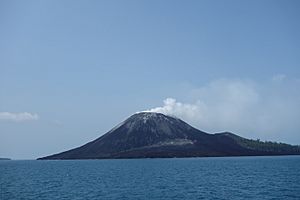2018 Sunda Strait tsunami facts for kids

A map of the region, with areas affected in blue.
|
|
| Date | 22 December 2018 |
|---|---|
| Time | around 21:27 WIB (14:27 UTC) |
| Location | Sunda Strait, Indonesia |
| Deaths | 430 |
| Non-fatal injuries | 1,459 |
| Missing | 150 |
On December 22, 2018, a powerful tsunami hit the coasts of Banten Province (Java) and Lampung Province (Sumatra) in Indonesia. This happened after the Anak Krakatau volcano erupted and part of it collapsed into the sea. Sadly, at least 430 people died, and 1,459 were hurt. The tsunami was caused by a huge underwater landslide that followed the volcano's eruption. The next day, it was confirmed that a large part of Anak Krakatau island had fallen into the ocean.
Contents
What Caused the Tsunami?
Indonesia is located on the Pacific Ring of Fire, an area where many earthquakes and volcanoes happen. It has 127 active volcanoes. One of these is Anak Krakatau, which means "child of Krakatau." This volcano appeared in 1927. It formed after the massive 1883 eruption of Krakatoa, which was one of the strongest eruptions ever recorded. That event killed over 36,000 people, mostly from huge tsunamis and ash.
In the months before the 2018 tsunami, Anak Krakatau had been very active. On December 21, it erupted for more than two minutes. This eruption sent an ash cloud 400 meters (1,300 feet) into the sky.
A very big tsunami also happened in 2004 around the same time of year, on December 26. That tsunami caused damage across many countries around the Indian Ocean, including Thailand and Sri Lanka.
The Tsunami Strikes
On December 22, 2018, at 9:03 PM local time, Anak Krakatau erupted. This eruption damaged nearby earthquake monitoring equipment. However, another station still detected constant shaking.
Indonesia's weather and geophysics agency (BMKG) noticed a tsunami around 9:27 PM local time. It hit the western coast of Banten. The agency had not detected any earthquakes before this. A spokesperson for the national disaster agency (BNPB) said that many buildings were destroyed. The waves hit beaches in Lampung and Banten around 9:30 PM.
Experts believed the tsunami might have been caused by an unusual high tide from a full moon. They also thought an underwater landslide after the volcano's eruption played a big role. Later, it was confirmed that the collapse of the volcano's southwest side caused the tsunami. The main part of the volcano was erupting underwater.
Indonesia had a warning system for tsunamis caused by earthquakes. However, there was no system for tsunamis caused by volcanoes. This meant there were no early warnings for the 2018 event.
People Affected
The disaster agency first reported 20 deaths and 165 injuries. The next day, these numbers increased to 43 deaths and 584 injuries. Most of the injuries happened in Pandeglang Regency. This area includes popular tourist beaches like Tanjung Lesung. The death toll kept rising, reaching 430 deaths, 1,459 injured, and at least 150 missing.
Among those who died was Aa Jimmy, a famous Indonesian actor and comedian. Several members of the Indonesian band Seventeen also lost their lives. This included bassist M. Awal "Bani" Purbani, guitarist Herman Sikumbang, road manager Oki Wijaya, and crewmember Ujang. Later, drummer Windu Andi Darmawan and Dylan Sahara were also found dead.
A video shared online showed the band's stage being hit by the tsunami during their concert at Tanjung Lesung. The stage collapsed, and the audience ran for safety. Tour groups from a state-owned electricity company and the Sports and Youth Ministry were also affected. Some of their members died, went missing, or were injured.
Damage Caused
The tsunami caused a lot of damage. About 400 houses near the coast in Pandeglang were destroyed or badly damaged. Nine hotels were also affected. In South Lampung, 30 other houses were heavily damaged. The road connecting Serang and Pandeglang was also cut off, making it hard for help to arrive.
Images for kids
-
Affected area across the Sunda Strait.
See also
 In Spanish: Tsunami del estrecho de la Sonda de 2018 para niños
In Spanish: Tsunami del estrecho de la Sonda de 2018 para niños





